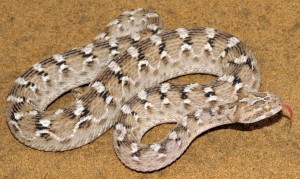Snakebite, a recent inclusion to the list of neglected tropical diseases drawn up by the World Health Organization, could be the most neglected of all neglected tropical diseases in the 21st century, says David Warrell, Emeritus Professor of Tropical Medicine at the University of Oxford.
India has long been considered as the nation with high incidence of snakebites but the full extent of this public health problem remained unknown. Published data from the late 19th and early 20th centuries suggested that the annual snakebite mortality in India was about 20,000, says Warrell. More recently from 2004 to 2009, the Government of India’s Central Bureau of Health Intelligence website reported an average of only 1,351 snakebite deaths each year. “It was clear from these disparities that official data grossly underestimated the size of the problem,” he adds.
A recent report in PLoS Neglected Tropical Diseases, co-authored by Warrell, confirms that there is a systemic under-reporting of snakebites. The findings from a national mortality survey in India, the Million Death Study, indicates that close to 46,000 people in the country die of snakebites every year, as opposed to the estimated 2000.
Because rural victims of snakebite rarely seek medical help from hospitals, researchers dispatched fieldworkers to conduct interviews with relatives and neighbors of the deceased. Being bitten by a snake is a sufficiently dramatic event, so people vividly recall details, Warrell had stated in an editorial in the National Medical Journal of India. Such recollection helps physicians decide the cause of death. Verbal autopsies, reliable in this context, may still be missing cases where the victims, bitten in the night, die of, say, “early morning paralysis,” he had cautioned.
Findings that emerged from the PLoS NTD survey: Snakebite deaths occurred mostly in rural areas (97%), were more common in males (59%), and peaked at ages 15–29 years (25%) and during the monsoon months of June to September. Based on these facts, and the universally observed truth that snakes don’t go out of the way to attack humans, there are simple strategies to reduce risk of snakebites.
More effective cures
Community education should encourage victims to seek medical, rather than traditional, help as soon as possible and recommend safe and effective first aid methods, Warrell adds. Health workers, nurses and doctors should receive better training in the management of snakebites, especially in the use of anti-snake venom (ASV), which is the only specific antidote.
There is a great diversity of venomous snakes in India but the polyvalent ASV is only raised against the “big four”: the spectacled cobra, saw-scaled viper, Russell’s viper, and the common krait. And 80% of the venom used to generate ASV comes from snakes in and around Mahabalipuram, in Tamil Nadu, he says.
So in a new research project, herpetologists from the Madras Crocodile Bank, toxicologists and clinicians throughout the country will work together to test the effectiveness of this ASV against venoms of Russell’s vipers from other parts of the country. Evidence suggests that there is significant variation in venom composition and toxicity even for the same snake species across the country, says Romulus Whitaker, renowned conservationist, herpetologist, and founder-director of the Snake Park in Chennai.
Speaking from close to four decades of clinical experience in rural Maharashtra, Himmat Bawaskar, MD, of Bawaskar Hospital and Research Centre, Mahad, says that medical textbooks now devote pages to treating envenoming by scorpion and snakebites, which wasn’t the case when he graduated from medical school in 1976. Today, better transport to primary health centers has also helped in timely interventions. “Each PHC is provided enough anti-venom against scorpion and snake venom,” he says, but concedes that this neither of these facts may be true for the entire nation.
In 2001, in a communication with Lancet, Bawaskar had made the case for finding a chemical antidote for snakebite, similar to the inexpensive drug he has used to great effect in the treatment of scorpion bite. But funding for this alternative hasn’t been forthcoming so far.
The rigors of 21st century medicine have yet to be brought to bear fully on this ancient scourge.
